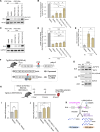Invention of an oral medication for cardiac Fabry disease caused by RNA mis-splicing
- PMID: 40203112
- PMCID: PMC11980850
- DOI: 10.1126/sciadv.adt9695
Invention of an oral medication for cardiac Fabry disease caused by RNA mis-splicing
Abstract
Pathogenic RNA splicing variants have emerged as promising therapeutic targets due to their role in disease while preserving coding sequences. In this study, we developed RECTAS-2.0, a small molecule designed to correct RNA mis-splicing caused by the GLA c.639+919G>A mutation, which leads to the inclusion of a 57-nucleotide poison exon, resulting in later-onset Fabry disease, particularly prevalent in East Asia. RECTAS-2.0 restored normal GLA mRNA splicing and α-galactosidase activity in patient-derived B-lymphoblastoid cell lines and induced pluripotent stem cell-derived cardiomyocytes. Furthermore, oral administration of RECTAS-2.0 effectively corrected splicing in a transgenic mouse model, demonstrating its substantial splice-switching activity and safety for clinical application. RECTAS-2.0 demonstrated potential applicability to other genetic disorders that involve similar exon competition. These findings underscore the therapeutic potential of RECTAS-2.0 for Fabry disease and highlight its broader implications for RNA splicing-targeted therapies in genetic disorders.
Figures




References
-
- Kim J., Hu C., El Achkar C. M., Black L. E., Douville J., Larson A., Pendergast M. K., Goldkind S. F., Lee E. A., Kuniholm A., Soucy A., Vaze J., Belur N. R., Fredriksen K., Stojkovska I., Tsytsykova A., Armant M., Di Donato R. L., Choi J., Cornelissen L., Pereira L. M., Augustine E. F., Genetti C. A., Dies K., Barton B., Williams L., Goodlett B. D., Riley B. L., Pasternak A., Berry E. R., Pflock K. A., Chu S., Reed C., Tyndall K., Agrawal P. B., Beggs A. H., Grant P. E., Urion D. K., Snyder R. O., Waisbren S. E., Poduri A., Park P. J., Patterson A., Biffi A., Mazzulli J. R., Bodamer O., Berde C. B., Yu T. W., Patient-customized oligonucleotide therapy for a rare genetic disease. N. Engl. J. Med. 381, 1644–1652 (2019). - PMC - PubMed
-
- Kim J., Woo S., de Gusmao C. M., Zhao B., Chin D. H., Di Donato R. L., Nguyen M. A., Nakayama T., Hu C. A., Soucy A., Kuniholm A., Thornton J. K., Riccardi O., Friedman D. A., El Achkar C. M., Dash Z., Cornelissen L., Donado C., Faour K. N. W., Bush L. W., Suslovitch V., Lentucci C., Park P. J., Lee E. A., Patterson A., Philippakis A. A., Margus B., Berde C. B., Yu T. W., A framework for individualized splice-switching oligonucleotide therapy. Nature 619, 828–836 (2023). - PMC - PubMed
-
- Boisson B., Honda Y., Ajiro M., Bustamante J., Bendavid M., Gennery A. R., Kawasaki Y., Ichishima J., Osawa M., Nihira H., Shiba T., Tanaka T., Chrabieh M., Bigio B., Hur H., Itan Y., Liang Y., Okada S., Izawa K., Nishikomori R., Ohara O., Heike T., Abel L., Puel A., Saito M. K., Casanova J.-L., Hagiwara M., Yasumi T., Rescue of recurrent deep intronic mutation underlying cell type-dependent quantitative NEMO deficiency. J. Clin. Investig. 129, 583–597 (2019). - PMC - PubMed
-
- Shibata S., Ajiro M., Hagiwara M., Mechanism-based personalized medicine for cystic fibrosis by suppressing pseudo exon inclusion. Cell Chem. Biol. 27, 1472–1482.e6 (2020). - PubMed
MeSH terms
Substances
LinkOut - more resources
Full Text Sources
Medical

